The drive for efficient performance
Dr. Nancy McGuire, Contributing Editor | TLT Feature Article January 2018
Automotive lubricants contribute to fuel efficiency in a host of ways beyond reducing engine friction.
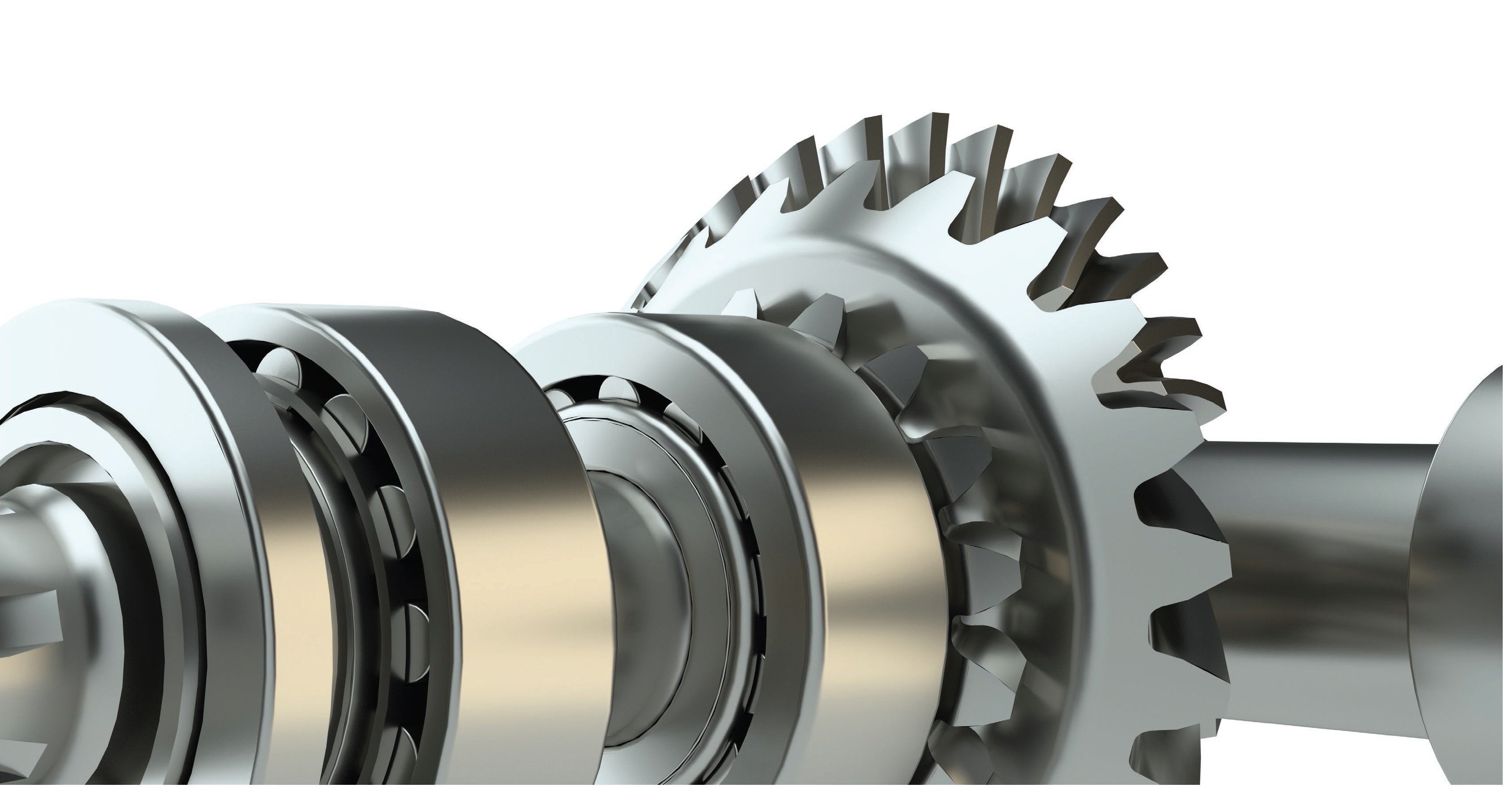
© Can Stock Photo / cherezoff
KEY CONCEPTS
•
Less friction makes a small difference in fuel economy, but better lubricants enable new hardware technologies that have a significant impact.
•
Regulations continue to be the main drivers toward greater fuel efficiency and lower tailpipe emissions.
•
New engine hardware and changing driving habits could motivate major changes in lubricant formulations and uses.
IT SEEMS PRETTY STRAIGHTFORWARD: smoother-running vehicles lose less fuel efficiency to friction. Find the friction points, apply the right lubricant, problem solved.
If only it were that simple.
Although automotive fuels are in plentiful supply for the time being, climate change and air quality concerns now drive efforts to reduce fuel consumption and tailpipe emissions. Cars are changing, too—they have smaller, more powerful engines, and their owners like it when they can go more miles between oil changes.
How much of an effect could a better lubricant have on fuel efficiency? Arup Gangopadhyay is one of 15 industry experts surveyed by Jai Bansal of Argonne National Laboratory for a 2017 Department of Energy workshop. Gangopadhyay, technical leader for powertrain research and advanced engineering for Ford Motor Co. in Dearborn, Mich., recalls the experts’ consensus that better lubricants could boost automotive fuel efficiency by about 0.5%-2% and maybe more for gasoline engines and diesel engines, although most of them put the range between 0.5% and 1.4%.
Measuring a lubricant’s effect on fuel efficiency is complicated by contributions from individual driving habits, differences between lab and road conditions, effects from the environment and the vehicle’s age. More than one property varies at once, and the effects of these properties vary with conditions.
Engine hardware may have a bigger effect on fuel economy, Gangopadhyay says: Engine technologies like turbocharging and direct injection can give you a 15%-20% bump in fuel economy. The effects of each new technology might not be additive, however. Adding two new technologies each that boost fuel economy by 2% doesn’t necessarily give you a 4% improvement, he explains. Also, hardware improvements are expensive. Design costs, testing, changes to the manufacturing processes—they all add up. Lubricants might only give you a 1.4% improvement in fuel efficiency, but that improvement comes at a relatively low cost, Gangopadhyay says, and every improvement contributes to getting your numbers into the target range.
CHANGES IN LUBRICANTS
Three properties of lubricants affect fuel efficiency, Devlin says. Viscosity under operating conditions determines how much energy is required to pump the fluid through the system. Boundary-region tribology comes into play at the top and bottom of the piston stroke and when an engine is first started up—where two surfaces come into contact with each other. When a thin (100-200 nanometer) lubricant layer separates surfaces, hydrodynamic tribology comes into play.
A lubricant’s ability to form and maintain a lubricating film between surfaces is largely a function of its viscosity under operating temperatures and pressures. Viscosity modifiers, generally polymeric materials, help the lubricant to maintain its viscosity over a wider range of temperatures. The fluid sees different conditions in the pump and in the engine, and it must be able to perform well under both sets of conditions.
Highly viscous lubricants can maintain a thicker film between surfaces, but they require more energy to pump through the system. Low-viscosity lubricants are easier to pump, but unless they can form and maintain an adequate film between the surfaces they are ineffective at reducing friction.
Some high-performance sports car engines require high-viscosity motor oils to maintain minimum oil film thickness and durability requirements. “Ford recommends using SAE 5W-50 viscosity grade for its GT-500 engine instead of the SAE 5W-20 or SAE 5W-30 used by other engines,” says Gangopadhyay. “You lose fuel economy with those [high-viscosity] oils, but high-performance vehicle customers aren’t necessarily concerned about it,” he adds.
For more mainstream passenger vehicles, lower-viscosity engine oils can improve fuel economy. In North America, SAE 5W-30 is the most recommended viscosity grade, but lower viscosity grades like SAE 0W-20 are gaining ground. One Japanese engine manufacturer is recommending an even lower viscosity grade, SAE 0W-16, in North America next year, Gangopadhyay says. SAE 0W-16 is more commonly used in Japan, where even lower viscosities like SAE 0W-12 are actively being pursued, he adds.
It takes less energy to shear the lower-viscosity engine oils as the piston ring moves against the cylinder liner, and that’s where the benefit comes from, he says. Lowering the viscosity has some impact on the durability of the engine components, however, and this effect must be taken into account. You have to strike a balance between low viscosity and durability that fits the engine design and materials used, he adds.
Surface finishes influence the choice of lubricants as well. A rough surface has higher surface asperities, and a thicker lubricant film is required to keep these asperities from coming into contact. However, even relatively smooth surfaces come into contact during boundary conditions such as the top and bottom of a piston stroke. “You always get this,” Devlin says. “You never avoid the situation where surfaces touch, but you try to minimize it.”
Polishing the surfaces or applying permanent coatings can be effective, but these processes are expensive. Another approach is to use surface coatings or chemical films that cap the tops of the asperities and reduce the friction between them. “Chemical films ‘smooth’ the surface if the surface has the right structure to begin with,” says Devlin.
Additives play a significant role in providing both additional fuel economy and wear protection while maintaining other performance attributes. “As a vehicle manufacturer, we are interested in not only fuel economy when engine oil is fresh but also during aging of engine oil in use,” Gangopadhyay notes. Generally fuel economy decreases with aging, and additives can play a greater role in maintaining this fuel economy, he adds.
Detergents help by preventing deposits from building up on engine surfaces. Using the right amounts of properly formulated detergents can reduce the low-speed pre-ignition (LSPI) problem that bedevils high-torque engines. (
See Low-speed Pre-ignition (LSPI).)
LOW-SPEED PRE-IGNITION (LSPI)
One area where lubricants can have a big impact is in reducing low-speed pre-ignition (LSPI). Smaller, lower-displacement engines using turbochargers and direct injection are gaining in popularity as a means of reducing weight and fuel consumption while keeping power levels high, but they are particularly prone to fuel ignition before the spark plug is triggered. This causes pressure spikes, noise and heavy knocking that can damage an engine. LSPI occurs at low engine speeds (1,200-1,500 rpm) and under high engine loads, and it limits efforts to maximize fuel economy.
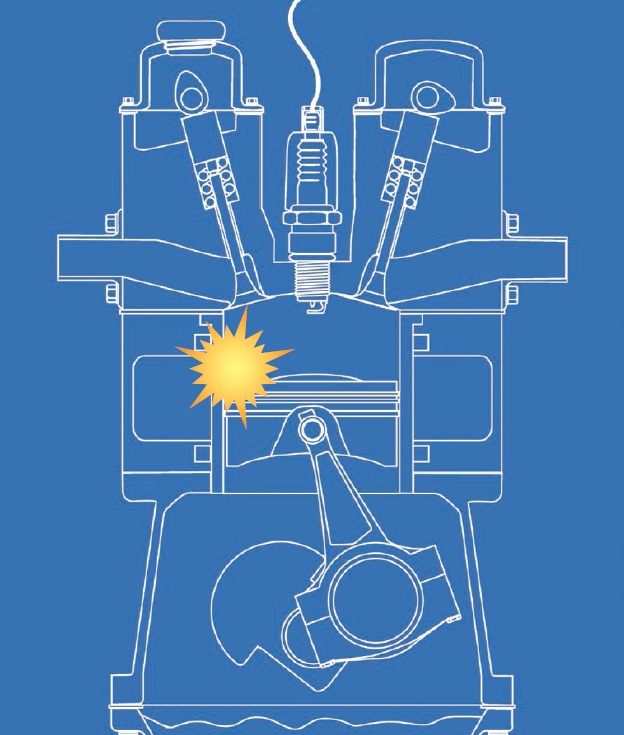 © Can Stock Photo / AlanCotton
© Can Stock Photo / AlanCotton
LSPI occurs at locations in the cylinder other than at the spark plug, so both the timing and the direction of the forces are wrong, says Mark Devlin, technical advisor for Afton Chemical. How can an engine oil reduce the occurrence of LSPI? Fewer deposits? Changes in the type of deposit? Changes in the volatility of the oil? Understanding how oils reduce LSPI is currently an active area of research, he explains.
Detergents can control engine deposits, Devlin says, but they also can increase LSPI unless they contain the right mix of other additives. Additives containing molybdenum and phosphorus reduce LSPI, but regulations place limits on the phosphorus content of lubricating oils. In particular, replacing calcium-based detergents with their magnesium counterparts can reduce LSPI, but Devlin notes that LSPI also can be controlled using engine oils with high amounts of calcium-based detergents if the oil has the proper mix of other additives.
Keeping engine torque levels within bounds also can reduce LSPI, but controlling torque can be highly dependent on individual driving habits.
Additional source: Ref. 4.
Lubricant additives reduce corrosion and the resulting pits and flaking by reducing the formation of acids in engine oils that occur as the result of combustion. Additives also reduce friction and help prevent deposit formation on turbo chargers, says Devlin.
New engines run hotter, which helps with fuel economy by promoting more complete fuel combustion. Lubricants must be able to flow the minute the ignition key is turned on a frosty winter morning, but they also must be able to form a lubricating film when these newer, hotter engines are running flat-out on a summer road trip. Synthetic base oils excel at high and low temperatures but offer similar performance to mineral oils under normal operating conditions. Synthetic oils cost more than mineral oils, so their cost effectiveness as engine lubricants depends on the conditions under which a vehicle is driven (
1).
It’s a different story when it comes to drivetrain lubricants like transmission and axle fluids. These fluids are not exposed to combustion byproducts, so they don’t oxidize as readily as do engine lubricants. Drain intervals on drive train fluids can easily equal or exceed the life of the vehicle, making pricy synthetic lubricants worth the investment (
1).
ENVIRONMENTAL REGULATIONS
In a 2012 report, EPA estimated that nearly 60% of U.S. transportation-related petroleum use and greenhouse gas emissions come from light-duty vehicles (
2, 3). Regulations on fuel economy and emissions control are one of the biggest drivers for increases in fuel efficiency, says Gangopadhyay. Consumers naturally want to spend less money at the gas pump, but with today’s comparatively low fuel prices, the drive to reduce pollutants in the air has gained in relative importance.
Current passenger cars, medium-duty passenger vehicles and light-duty trucks (model years 2017-2025) are required to meet Phase 2 of the Clean Air Act regulations. If all goes as predicted, model-year 2025 vehicles will emit half of the greenhouse gases that their 2010 predecessors did, with a fleet average of more than 54 miles per gallon of gas (
1, 2). Despite political pressure to relax these regulations in the U.S., domestic automakers also must keep an eye on fuel economy standards overseas, as well as on U.S. states with strict regulations (
see Figure 1) (
4).
VEHICLE EMISSIONS vs. MILES TRAVELED
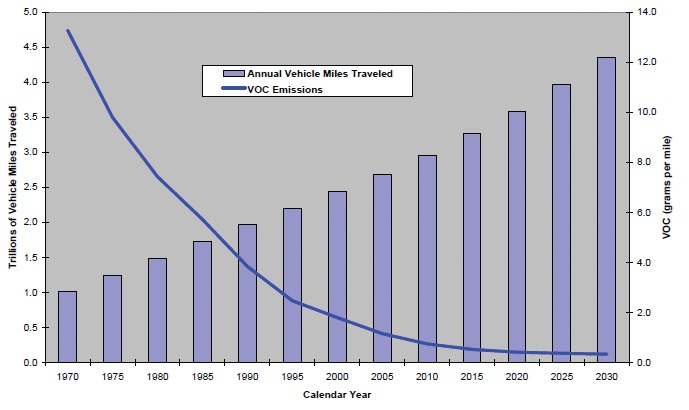 Figure 1. Since 1970, vehicle emissions of volatile organic compounds have plummeted, even as car, SUV and pickup truck travel miles have steadily increased. (Figure courtesy of the U.S. EPA. Available here.)
Figure 1. Since 1970, vehicle emissions of volatile organic compounds have plummeted, even as car, SUV and pickup truck travel miles have steadily increased. (Figure courtesy of the U.S. EPA. Available here.)
In the U.S., corporate average fuel economy (CAFE) standards, first enacted in 1975 after the Arab oil embargo, set a minimum level for fuel economy averaged over a manufacturer’s fleet of current model-year passenger cars or light trucks. Thus, a company can offset a popular but inefficient model with one or more highly efficient models, but the fleet average must meet the minimum standard.
Japan’s Top Runner approach, incorporated under its Energy Conservation Act, sets moving baselines pegged to the performance of the product in a particular market category that has the highest energy efficiency at the time the standard is set. Thus, one company can reset the bar with a highly efficient vehicle, and its competitors must scramble to catch up. This approach is applied to everything from rice cookers to electric toilet seats, as well as passenger cars and freight vehicles (
5).
Efficiency entails converting more of the fuel to mechanical energy and sending less of it out the tailpipe, so regulators not only watch the miles per gallon (or liters per 100 kilometers), they set standards for exhaust emissions as well. For example, the European Union’s Euro 6 standard covers maximum allowable levels of several specific pollutants in the exhaust of all mass-produced cars sold after September 2015. Euro 6 standards cover nitrogen oxides, carbon monoxide, total hydrocarbons and particulate matter (mainly soot from diesel cars). A result of lowering these emissions is a reduction in carbon dioxide emissions and an increase in fuel economy (
6).
Particulate emission regulations pose a particular challenge, says Gangopadhyay. Fuel particulate filters reduce tailpipe emissions, but ash from metal-containing engine oil additives can plug these filters. Thus, lubricant ash content becomes more important as regulations become more stringent. Particulate emission regulations in Europe have already driven ash content to 0.8% compared to about 1% in North America, he notes.
EVOLVING OIL STANDARDS
In response to government-mandated standards, several professional organizations and industry consortia have come up with standards and specifications of their own. For example, the International Lubricants Standardization and Approval Committee (ILSAC), together with SAE, API and ASTM, formed the Engine Oil Licensing and Certification System (
7).
“The industry is currently working on GF-6,” says Gangopadhyay, whose employer, Ford Motors, is a member of ILSAC. The ILASAC GF-6 specification, which applies to passenger-car lubricants that are used for spark-ignited internal combustion engines, includes two categories. GF-6A lubricants are fully backward compatible with the current GF-5 standard but offer better fuel economy (and fuel economy retention), engine protection (including wear protection under boundary conditions and reduction of low-speed pre-ignition) and performance, while maintaining engine and oil durability (reduction in oil aeration and prevention of deposit buildup, among other things).
GF-6B is more forward looking and covers lower-viscosity oils, including the new SAE 16 viscosity grade, that perform well in newer engines (
8). This standard also will apply to oils having viscosity less than 0W-20, once SAE defines and accepts these grades. This focus on lowering engine oil viscosity comes in response to recent improvements in engine hardware, but it also helps with fuel economy. Even without the GF-6 standard, there has been a marked shift toward using 5W-20 (and even 0W-20) viscosity grades rather than 10W-30 and 10W-40 grades.
Diesel engine oils also are trending toward lower viscosities, better resistance to oxidation and longer drain intervals. One issue with diesel engines is that differences between on- and off-road engine designs are widening, and there may come a time when two different categories of diesel engine oils are required (
9).
HARDWARE CHANGES
Newer vehicle designs can make a big difference in fuel economy, says Gangopadhyay. Start-stop engines, for instance, save fuel by cutting off when the car is standing still and quickly starting again when the driver engages the clutch (manual transmission) or releases the brake pedal (automatic transmission).
Variable displacement engines (e.g., Chrysler’s Hemi) adjust to engine loads by providing more displacement for highway driving and less for city driving. This technology is more common for larger engines, and it has come into greater usage since the mid-2000s. The most common means of varying engine displacement is to take some of the cylinders in and out of service. On the highway, all cylinders are in operation at full pressure. In a conventional engine, overall cylinder pressure falls under light-load conditions. Variable displacement engines keep intake and exhaust valves closed for some of the cylinders when the engine is under a lighter load. The pressure in the remaining cylinders remains higher, which can increase in-town fuel efficiency significantly. Some newer variable displacement engines also cut fuel delivery to the cylinders that are not being used.
Another way to keep pressure in the cylinders high is to compress the air that flows into the engine using a turbocharger. More air available for combustion means that you also can inject more fuel, releasing more chemical combustion energy and giving you more power from each stroke of the cylinder. Turbochargers increase fuel economy by enabling smaller, lighter engines to deliver more power and maintaining peak power across a wider range of engine speeds (
see Figure 2).
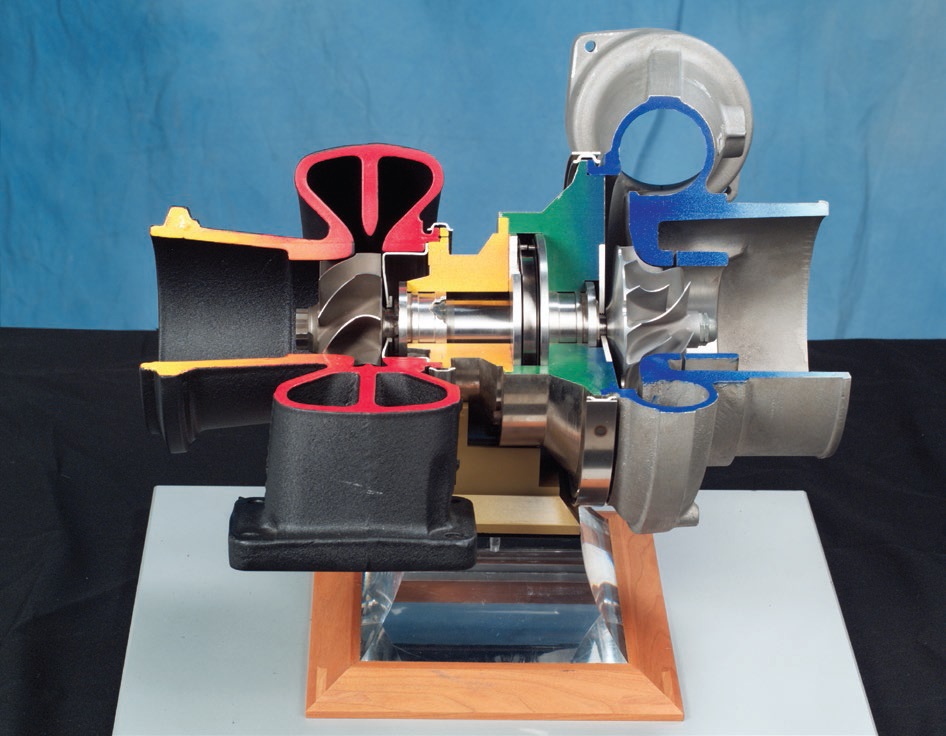 Figure 2. Cutaway model of a turbocharger. (Figure courtesy of NASA.)
Figure 2. Cutaway model of a turbocharger. (Figure courtesy of NASA.)
Another way to convert more of the fuel’s chemical energy into mechanical motion and less into waste heat is to run the engine at higher torque. This requires good lubricant films in the engine, transmission and axles to keep adjacent metal surfaces separated without impeding the transfer of mechanical energy from one system to the next.
High-torque engines require lubricants that separate the piston and cylinder surfaces (but not so much that you lose the force from fuel ignition), and engine oils must be formulated with additives that address the LSPI issue. Torque from the engines is transferred to the transmission, where the clutches must engage properly to transmit force. Clutches that don’t engage properly cause noise, vibration and harshness (NVH), resulting in a loss of control, but well-formulated transmission fluids can reduce NVH issues. From the transmission, the rotational energy goes into the axles. Here, lubricants allow gear teeth to engage properly to transmit motion from one gear to the next while keeping surfaces far enough apart to separate any surface asperities. This reduces gear fatigue by preventing asperities on two gear surfaces from pulling against each other, transmitting stress to the bulk metal below and producing strain, which initiates crack formation.
When a car is accelerating or climbing a hill, there’s a sweet spot (around 2,000 rpm) where the engine delivers the most torque and, thus, the best fuel economy, before it needs to shift to a lower gear to deliver the extra power (
see Figure 3) (
1). More gears make for smoother shifting, and the engine spends more time running at a fuel-efficient speed. These smoother-shifting transmissions require different fluids than do the older transmissions, says Devlin. You can use the older fluids for these transmissions, he adds, but it’s not optimum.
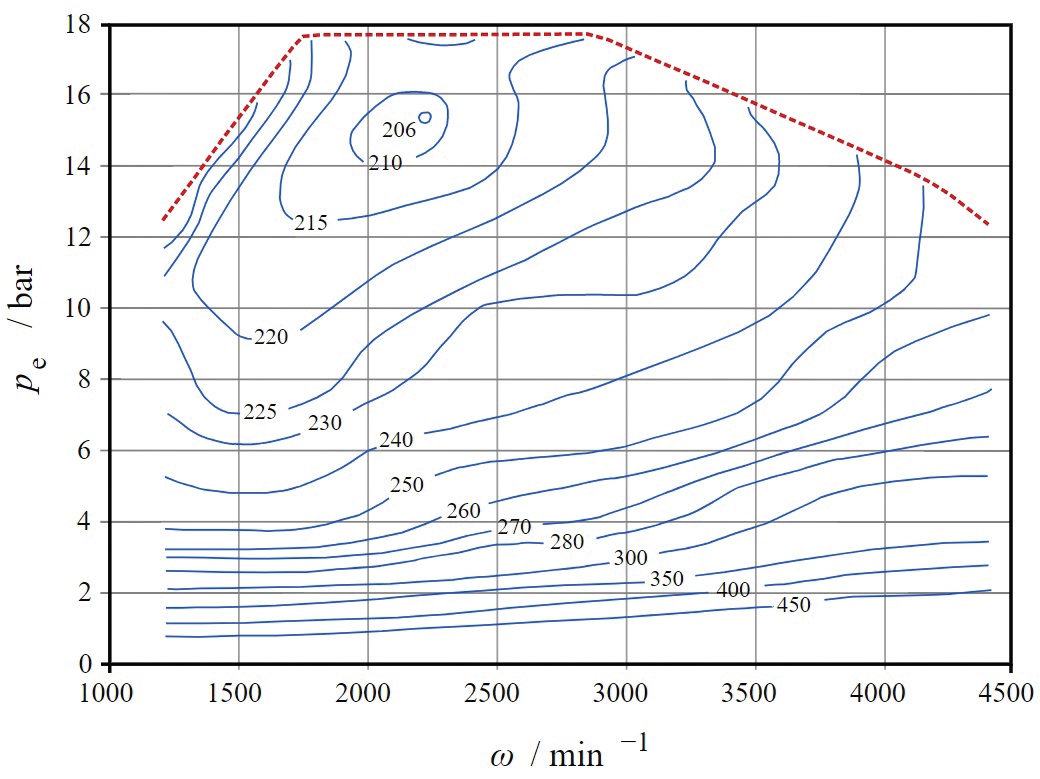 Figure 3. Brake-specific fuel consumption (BSFC) [g/kWh] for a 3-cylinder, 1.5-liter diesel engine, plotted as mean effective pressure (related to torque) versus engine rotational speed. (Figure courtesy of Motortechnische Zeitschrift MTZ 1/2005; Der neue Dreizylinder-Dieselmotor von Mercedes Benz für Smart und Mitsubishi. Authors: Digeser, Steffen et al.)
Figure 3. Brake-specific fuel consumption (BSFC) [g/kWh] for a 3-cylinder, 1.5-liter diesel engine, plotted as mean effective pressure (related to torque) versus engine rotational speed. (Figure courtesy of Motortechnische Zeitschrift MTZ 1/2005; Der neue Dreizylinder-Dieselmotor von Mercedes Benz für Smart und Mitsubishi. Authors: Digeser, Steffen et al.)
Yesterday’s four-speed transmissions are giving way to 6, 8 or 10 speeds—or continuously variable transmissions that essentially give you an infinite number of speeds within a given range. Power train integration calibrates the engine speed with the transmission gear changes to increase fuel economy and smooth out the gear shifts, Gangopadhyay notes.
GAME CHANGERS
Continuous transmissions, stop-start engines and turbochargers are changing the landscape, but they are all used with vehicles having internal combustion engines that run on diesel or gasoline. Battery electric vehicles have no engines, of course, but they still have transmissions, axles, gears and bearings requiring lubrication.
Hybrid cars still have internal combustion engines, assisted to varying degrees by electric motors. Better fluids could improve fuel economy in these engines, depending on the type of hybrid architecture. For example, in the PowerSplit transmission configuration, ring and pinion gears, as well as the electric motor and stator, are cooled by the transmission fluid, Gangopadhyay explains. Electric motors are more efficient at lower temperatures, and if heat can be removed faster using fluids with higher thermal conductivity, the motors can run cooler, he adds. But in other hybrid architectures like P2 hybrids, the vehicle may use a conventional transmission with a torque converter and clutches.
Homogeneous charge compression ignition (HCCI) engines are internal combustion engines, and their combination of fuel-air mixtures and compression-driven ignition helps them achieve both fuel efficiency and low emissions. Mazda plans to introduce its HCCI engine to the market in 2019 (
10). (
See Homogeneous Charge Compression Ignition (HCCI) Engines.)
HOMOGENEOUS CHARGE COMPRESSION IGNITION (HCCI) ENGINES
One upcoming technology, homogeneous charge compression ignition (HCCI) engines, combines the fuel efficiency of diesel engines with the lower emissions of gasoline engines. HCCI engines inject the fuel during the intake stroke and mix the fuel with air, as gasoline engines do. Like diesel engines, they compress the fuel-air mixture until it ignites spontaneously.
HCCI engines emit very low levels of nitrogen oxides, even without a catalytic converter, but post-treatment is still required to meet acceptable standards for hydrocarbon and carbon monoxide emissions. HCCI engines use hybrid fuels that help control emissions and burn rates.
HCCI engines don’t control ignition timing with spark plugs or with fuel injection timing, so the temperature inside the cylinder has to be kept within a narrow temperature range to control the moment when compression causes the fuel to ignite.
Mazda announced this year that it is putting its Skyactiv-X HCCI engine into production in 2019. Mazda solved the temperature-range problem by adding a spark plug to use under non-ideal circumstances like cold starts or high loads. This introduces a second problem—how to transition between using compression and using a spark plug to ignite the air/fuel mixture. Mazda’s not saying how it addressed this issue.
Source: Ref. 10.
Better engine designs and lubricant formulations can only take you so far, however. “Whenever we look at any study on fuel economy, the biggest that affects fuel economy is driving habits,” says Devlin. Sudden starts and stops and excessive speed are going to lower your fuel economy. “You can make a better fluid, but it’s how people drive that matters,” he says.
Good driving habits can reduce fuel consumption by as much as 10%-40% (
11). How would better lubricants, and the fuel economy they enable, change if on-board computers were doing the driving instead of impulsive humans?
It all depends on the vehicle, and the potential effects on powertrains and lubricants are far from clear. “We don’t have any data on this yet,” Gangopadhyay says. An all-electric vehicle, self-driving or not, has no engine and, thus, no need for engine oils. Self-driving hybrid vehicles would have to find a sweet spot between getting the best fuel economy in the engine and the best power and recharge interval from the battery. Will people like the ride they get under those optimized conditions? Customer acceptance is a big unknown at this point, he adds.
Another potential effect of self-driving cars is an outgrowth of a trend already apparent in urban areas. A typical one-driver car spends about 96% of the time unused in a parking space or garage, Gangopadhyay says. However, with ride sharing services like Uber, where one driver carries a series of passengers throughout the day, or ZipCar, where multiple drivers rent the same car for short periods of time, cars spend much more time on the road. Self-driving cars could accelerate the trend toward ride sharing, he adds. Today’s lubricants are designed for a 10,000-mile drain interval, but a car that is on the road most of the time could rack up 10,000 miles every couple of months. This could drive demand for lubricants with even longer drain intervals.
ALL KINDS OF VEHICLES, ALL KINDS OF CONDITIONS
Even as new hardware technologies enter the marketplace, “We can’t move too far ahead,” Devlin says, referring to putting new fluid technologies on the market. “We could do things with modern engines, but we also have to deal with older cars, and that’s a major challenge. Cars on the road today range from fresh off the showroom floor to 20 years old or more, and oil additives have to work for new and old engines. But it takes energy to manufacture a new car, so keeping older cars on the road saves energy that way. Durable cars have a benefit,” he adds.
Older cars are a consideration, but older oil is, too. “You have to measure fuel economy after you’ve been using the oil for a while, not just for fresh oil,” says Gangopadhyay. Lubricants have to retain fuel economy under aged conditions to meet federal certification standards, so you test the oil at 4,000-6,000 miles for certification. The MPG figure you see on a new car’s sticker represents the model’s performance using oil that has 4,000-6,000 miles on it, he says.
Some fuel economy protocols from the 1970s have to be updated to be relevant to today’s vehicles, says Devlin. With all the new hardware designs and road conditions—what works best in the field? Federal dynamometer test procedures for determining miles per gallon were last updated in 2006 and don’t really replicate today’s road conditions, he says, adding, “What’s a ‘typical’ highway?” Emissions tracking devices exist today, he notes, “but we’re trying to standardize them to give us the information we really want.”
“Can you specify a worldwide driving cycle?” Devlin asks. What type of lubricant can work as well in an urban traffic jam as it does on a desert highway or climbing the side of a mountain? Is there a way to design lubricants for the way people drive in Indian cities, on U.S. freeways and in the Australian outback? “The technical challenges of developing a lubricant are easy compared to sorting all that out,” he says.
However, even if you can’t get a strictly accurate MPG figure, fuel efficiency regulations are already doing what they are supposed to do, Devlin says. Even if your real-world mileage isn’t the same as what’s on the sticker, fuel efficiency has been steadily increasing over the years.
Although regulations are the main driver in the push for fuel efficiency, Ford monitors customer data as well, Gangopadhyay says. Fuel economy is usually in the top five customer priorities, depending on gasoline prices. Staying ahead of the competition plays a smaller role. “Generally everyone meets the minimum regulatory requirements, but that’s by no means an easy task,” he says, so meeting regulatory standards tends to outweigh the other factors.
The same engines go to different parts of the world, Gangopadhyay says, and automakers have to meet the minimum requirements for fuel economy and emissions. Ford doesn’t make different engines specifically for one particular country, but they put a heavier focus on different technologies for different countries, he explains. They may remove features like start-stop engines if a market is highly focused on reducing cost or if some features aren’t needed to meet regulations. Likewise, because Europeans tend to drive smaller cars, fewer V8 engines go to Europe than to North America.
A MULTIFACETED CHALLENGE
Getting your fuel economy numbers up requires tackling the problem from all sides, so even though lubricant formulation doesn’t have the greatest impact, improved lubricants play a role in getting your numbers within specification. “Even a 0.2%-0.3% fuel economy improvement is still important to meeting requirements,” Gangopadhyay says. “We cannot ignore that any more—everything contributes.”
“It’s a multidisciplinary problem. You need to be able to talk to each other,” Devlin adds.
REFERENCES
1.
Cummins MPG Guide, “Secrets of Better Fuel Economy: The Physics of MPG.” Available
here.
2.
EPA Regulatory Announcement EPA-420-F-12-051. (August 2012), “EPA and NHTSA Set Standards to Reduce Greenhouse Gases and Improve Fuel Economy for Model Years 2017-2025 Cars and Light Trucks.” Available
here.
3.
Insight from Infineum International Limited. “Why ILSAC GF-6?” Available
here.
4.
Smith, A. (October 17, 2017), “Consumers Should Drive EPA Review of Climate Rule: Carmakers,” Bloomberg BNA Environment and Energy Report.
5.
Ministry of Economy, Trade, and Industry; Agency for Natural Resource and Energy (Japan). (March 2015), “Top Runner Program.” Available
here.
6.
The International Council on Clean Transportation. (June 2016), “A technical summary of Euro 6/VI vehicle emission standards.” Available
here.
7.
ILSAC Oil Specifications. Available
here.
8.
Lubrizol Corporation. “ILSAC GF-6,” Lubrizol Additives 360. Available
here.
9.
Fowler, R. (2016), “20 minutes with Leonard Badal,” TLT,
72 (1), pp. 16-20. Available
here.
10.
Warner, R. (August 24, 2017), “Here’s How Mazda’s New HCCI Engine Works,” AutoWeek. Available
here.
11.
U.S. EPA Office of Transportation and Air Quality. “Driving More Efficiently.” Available
here.
 Nancy McGuire is a free-lance writer based in Silver Spring, Md. You can contact her at nmcguire@wordchemist.com
Nancy McGuire is a free-lance writer based in Silver Spring, Md. You can contact her at nmcguire@wordchemist.com.